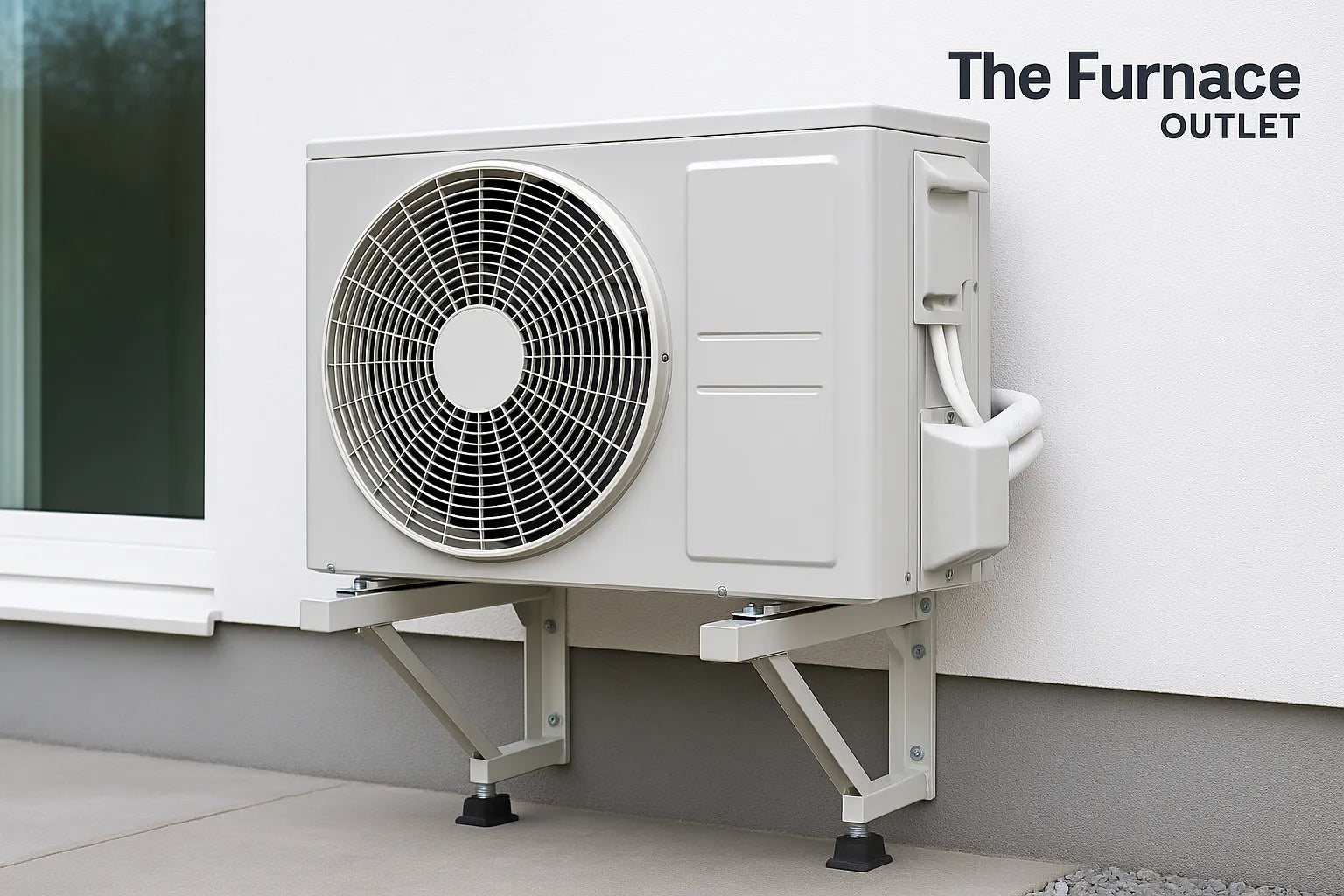Key Takeaways
-
Pick the right bracket: wall, ground, roof, or pad.
-
Choose a bracket rated for 2× the unit’s weight.
-
Use weather-resistant materials like coated or stainless steel.
-
Maintain 12–18 in clearance and follow code for height.
-
Add rubber pads or dampers to reduce vibration and noise.
Mini‑Split Brackets 101
Mini‑splits are booming across the United States, helped by fresh 2025 tax credits of up to $2,000 for qualifying heat‑pump systems. Yet one detail trips up many homeowners: how to support the outdoor condenser safely. A bracket seems minor until rust, wobble, or blocked airflow slices years off a $2,000‑plus unit. This guide breaks bracket choices into clear, kid‑friendly language while adding insights only HVAC pros normally share. You’ll learn the bracket types, how to size them, and how to dodge the mistakes that cause rattling nights and warranty headaches—all while keeping U.S. building codes in mind.
Installing a new system? Start with a DIY mini-split kit.
The Big Problem: Wrong Bracket, Big Headaches
Choosing the wrong support leads to three costly issues: reduced efficiency, loud vibration, and premature failure. An undersized bracket lets the condenser sag, bending refrigerant lines and stressing the compressor. Poor clearance chokes airflow, forcing the unit to run hotter and longer. Missed vibration pads can send a constant hum through walls—a top complaint in HVAC forums.
Solving these issues up front means fewer service calls and better energy bills. Remember, most condenser warranties require proper mounting, so the bracket is not optional insurance; it’s step one of a reliable system.
Four Main Types of Mini‑Split Mounting Supports
Wall‑mounted brackets bolt to masonry or studs, keeping the unit 12–18 inches off the wall for airflow. They’re perfect where yards are tight or floods are common.
Ground stands sit on concrete or gravel, raising the condenser above snow or debris—great for northern states.
Roof frames spread weight across rafters when no wall or ground space exists, but need a pro to confirm load limits.
Pads (dense plastic or rubber) aren’t brackets at all; they rest on level ground to cut vibration and cost. Combining pads with anti‑vibration feet often gives the quietest result. Pick a type that matches your climate, space, and service‑access needs.
Capacity and Weight Rating: Safety First
Typical mini‑split condensers weigh 60–150 lb. Pros pick brackets rated for at least double that—so a 150‑lb unit gets a 300‑lb bracket. This safety margin handles wind, ice, and dynamic compressor forces. Always cross‑check your model’s spec sheet for “Net Weight” and “Operating Weight” (some add 5–10 lb of refrigerant). Over‑engineering may cost an extra $20 but prevents cracked mortar or bent metal later. If your home faces hurricanes or seismic activity, look for brackets tested to ASTM or ICC‑ES standards for uplift and lateral loads.
Need the right accessories? Shop mounting kits and pads.
Material and Durability: Built to Last
Powder‑coated steel is the budget hero—resists rust for 5–10 years in average U.S. climates.
Galvanized steel adds a zinc layer that pushes life to roughly 12 years.
Stainless steel (304 or 316) laughs at coastal salt and can hit 20 years or more, making it worth the premium in Florida, the Carolinas, or the Gulf.
Whichever you choose, keep hardware consistent: stainless bolts in stainless brackets avoid galvanic corrosion. A quick yearly rinse removes salt or fertilizer spray that can shorten any metal’s lifespan.
Using a ground stand?Choose a compatible outdoor condenser.
Location, Clearance, and Code Rules
Mount wall brackets 2–6 ft above grade, high enough to clear local snow depth and flood maps. Keep at least 12 in behind and 14 in on each side so the condenser fan can breathe; some brands ask for 24–36 in on top. Avoid walls that bake in full afternoon sun or face driveways where kicked‑up grit clogs fins. In multi‑unit setups, stagger condensers vertically to prevent hot exhaust from one feeding into another. Always verify local code for minimum distance from property lines and disconnect switch placement.
Pair your unit with confidence.Browse matched indoor air handlers.
Quiet Comfort: Taming Noise and Vibration
Metal transmits sound like a drum. The fix is simple: rubber isolator pads or spring dampers between the bracket and condenser. Quality kits ship with them preinstalled; budget kits require separate purchase but are worth every cent. On brick homes, choose brackets with thicker backplates to spread load and reduce resonance. If placing near a bedroom, consider a ground stand on a composite pad—tests show 3‑5 dB lower indoor noise than rigid wall mounts. Re‑check tightness after 48 hours of run time; settling can loosen bolts and bring the buzz back.
Live near salt air?Pick long-lasting stainless option
Installation Tips for a Safe & Efficient Setup
-
Read both the condenser and bracket manuals—bolt patterns vary.
-
Mark stud or block locations; use sleeve anchors for masonry, lag bolts for lumber.
-
Pre‑assemble bracket arms on the ground for easier leveling. Many kits include magnetic levels for accuracy.
-
Lift the condenser with a friend; never rely on one person and a ladder.
-
Torque bolts to spec, then add anti‑seize compound to exposed threads.
-
Finish by running the line‑set with a gentle drip loop and UV‑rated insulation.
Want a quieter install? Get low-noise support gear.
Common Mistakes + Quick FAQ
The biggest slip‑ups are undersized brackets, short arms that block airflow, and anchors sunk into weak siding instead of solid framing. Double‑check load ratings and clearances, and you’ll avoid 90 % of service calls.
Frequently Asked Questions
Can I put the condenser on a wooden deck?
Only if the deck is structurally rated for 4× the unit’s weight and vibration pads are used.
Do I still need vibration pads on a ground pad?
Yes—pads cut noise and keep bolts from walking loose.
How far from my oil tank must the condenser sit?
At least 3 ft, but check local fire code for your state.
Which bracket lasts longest at the coast?
316‑grade stainless with stainless hardware.







